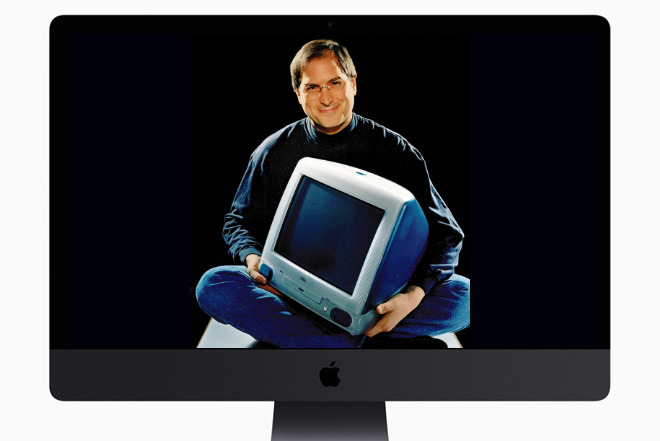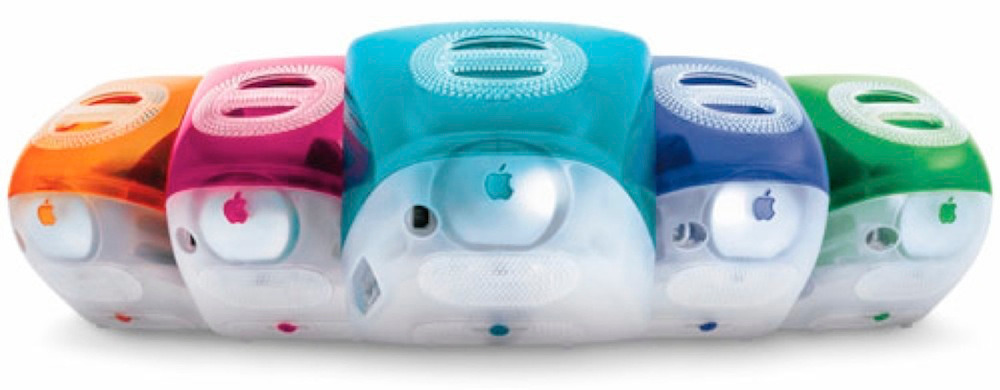The iMac is the machine that famously saved Apple back in 1998 — but it didn't stop there. Rarely standing still, it has kept at the forefront of Apple design, yet today's iMac has the same design goals it always has. AppleInsider looks back at the beginning of the line, all the way to today.
iMac: The origin
The story of the iMac is well known. Shortly after Steve Jobs returned to Apple and then took over the interim CEO chair in 1997, he commissioned a new signature Apple computer for the consumer market.
This computer would be simple to use, and connect easily to the Internet. It would also look unlike anything Apple or any of its competitors had ever made before.
That computer, the original iMac, became Apple's most successful product in years. The mixture of beautiful design and functionality not only stabilized the company, but set Apple on the path to its greatest successes in the early part of the new century.
The first iMac was introduced in May of 1998 and arrived on the market on August 15 of that year.
This is the story of how the iMac came together and what it became.
iMac Origins
The first mention of the iMac came when Steve Jobs said at its May 6, 1998 announcement that it "comes from the marriage of the excitement of the Internet with the simplicity of Macintosh. Even though this is a full-blooded Macintosh, we are targeting this for the #1 use consumers tell us they want a computer for, which is to get on the Internet, simply and fast."
The idea was that Apple needed to make a big splash with its first computer upon Jobs' return to the company. The goals included making a machine that could easily connect with the Internet, that would achieve something close to "plug and play" functionality. A product that would get people talking about Apple again.
Apple came up with a form factor drastically different from the PCs that were popular at the time. But, at the same time, it was reminiscent of Apple's all-in-one Mac line that it introduced in 1984.
The original iMac was the first major Apple product designed by newly appointed Senior Vice President of Industrial Design Jony Ive, who has been the top designer for all of the company's products ever since. And, the machine's unique look was a major part of the selling of the iMac.
The iMac has often been described as "candy colored," and that's not a coincidence. Ive told an interviewer at the time that he actually consulted with candy industry professionals while designing the iMac.
"The translucent resin presented a problem because of the high volume of products we needed to produce," Ive told the Australian magazine PC and Tech Authority. "We had to make sure that the colour and level of translucency were exactly the same in the first computer and every one thereafter."
"This led us to finding a partner who does a lot of work in the candy industry, because a lot of candies are translucent," added Ive. "These guys have so much experience in how you control the compounding and a great understanding of the science of colour control."
There was also some negativity, directed at the PCs leading the market at the time.
In his keynote, Jobs ripped the incumbent PCs, especially Dell's, denouncing them as sporting "crummy displays" and adding that "these things are ug-ly." And in a series of advertisements, featuring actor Jeff Goldblum, Apple questioned why computer design had been so unimaginative in the years before the iMac.
"Do you ever ask anybody what their favorite color is?," Goldblum asked in one of the ads. "How many times do they say beige'? Never. Because it's one of the worst colors. It's hardly even a color, it's like oatmeal or sand. There's nothing — it's beige, it's boring, it's bland.
"Now, computers- why, in heaven's name, have the people who have made computers before never done anything but beige? That's nuts! Have they been in thinking jail?"
What's in a name?
The ads were created by Apple's longtime creative firm of TBWA/Chiat/Day, under the auspices of creative directors Lee Clow and Ken Segall.
Segall plays another important part in the history of the iMac, beyond just the advertising. According to his own autobiography, he gave the iMac its name.
As Segall wrote in his book, Insanely Simple: The Obsession That Drives Apple's Success (excepted in Fast Company), Segall and the other ad people were summoned to Cupertino in the spring of 1998 to see the new computer, which was meant to fulfill the promise of their "Think Different" advertising campaign of the previous year.
According to Segall, Jobs had planned to call the device "MacMan," but had challenged the creative team to come up with a better name that that. While acknowledging that "MacMan" had been Phil Schiller's idea, Jobs asked the admen to include "Mac" in the name, while also emphasizing its Internet capability.
Going by Jobs' instructions, Segall says he came up with "iMac."
"It seemed to solve all the problems at once. It was clearly a Mac," Segall wrote. "The 'i' conveyed that this was a Mac designed to get you onto the Internet. It was also a perfectly succinct name-just a single letter added to the word 'Mac.' It didn't sound like a toy and it didn't sound portable."
"Using the word Mac' in the product name was more of a revolution than you might realize," said Segall. "At that time, Macintosh' had yet to be shortened to a more colloquial "Mac" in the name of any Apple computer. For simplicity and minimalism, 'iMac' seemed to be perfect."
Jobs replied that he hated all of the names and preferred MacMan, but further back and forth led to "iMac" carrying the day.
Of course, Segall also noted that the use of the "i" could later be adapted to future Apple products. Which, of course, it was.
The reception
The iMac arrived on the market in August of 1998, and the reception was positive.
Walt Mossberg, then of the Wall Street Journal, raved about the iMac, starting his review with "these words are being created on the coolest-looking personal computer I've ever used. It's a handsome two-tone devil, sort of blue-green and off-white, tapered at the rear, with a crisp, built-in 15-inch monitor and internal stereo speakers." The influential consumer tech critic went on to say that "the boldest Macintosh model Apple Computer has rolled out since the 1980s."
Audiences responded to the product too. After years of Apple's computers languishing in the market share rankings, the iMac was the number one selling personal computer in the quarter that comprised the 1998 holiday season. That was according to PC Data statistics, cited by the New York Times. At the time, the iMac sold for an average price of $1,224.
But when it came to the iMac, there was much more to come.
Criticism started here too
That included criticism for what the iMac lost and in retrospect, this was the start of a recurring trend. Apple drops some hardware features, it is decried for doing so and pronounced doomed, then everyone else drops them too.
The New York Times was chiefly positive about the iMac but heavily criticized its lack of a floppy drive — and the ability to connect a printer. You could buy a $70 adapter or you could wait for Hewlett Packard's newly announced USB printed to ship.
"This is a double whammy because there is no way to take a disk from the iMac and use it to print on someone else's machine," the Times cautioned. "Most of the consumers Apple is trying to appeal to live in a world where floppy disks are important."
The technology press, which you'd imagine would be more interested in future developments, had some conservative reactions — and over-reactions.
"Apple will never be the great company it could've been," wrote Hiawatha Bray in the Boston Globe in 1998. (Article requires subscription.) "The iMac will only sell to some of the true believers. It's an astonishing lapse from Jobs, who should've learned better. The iMac is clean, elegant, floppy-free and doomed."
Usually this kind of criticism quietens down when sales figures are great and the iMac's were spectacular. Reportedly it sold 278,000 sold in its first six weeks, rising to around 800,000 by the end of 1998. According to Jobs biographer Walter Isaacson: "Most notably, 32 percent of the sales went to people who were buying a computer for the first time, and another 12 percent to people who had been using Windows machines.
On April 19, 2001, Apple announced that it had shipped its 5 millionth iMac. "Simply put, the iMac has redefined the consumer and education computer," said Jobs at the time.
Perhaps unable to resist a nod to original criticisms, he added that the iMac had brought in: several industry firsts including USB, FireWire, desktop movies, wireless networking, quiet fan-less operation and world-class design."
Leadership in colors
Yet it was design that Apple that was being both praised and mocked for.
The original iMac had been available only in what Apple called Bondi blue but that soon changed. In 1999, Jobs announced five new iMacs in the colors blueberry, lime, strawberry, grape and tangerine. In 2000, those were replaced by indigo, ruby, sage, graphite and snow.
Then in early 2001, ruby, sage and snow were out and patterns were in — this was when the Flower Power and Blue Dalmation iMacs were released.
There were many technical improvements and updates to the iMac over this time. But, it was the color that Apple concentrated on and it was the color that failed to impress Bill Gates.
Speaking a year after all of these colors were introduced, and eight months after the 5 millionth iMac was sold, Gates still trashed Apple in regards to the iMac.
He was at a January 2002 gathering of financial analysts in Seattle and spoke to the point of both Apple's success and how it was now producing iMacs in many colors.
"The one thing Apple's providing now is leadership in colors," he said. "It won't take long for us to catch up with that, I don't think."
Isaacson reports that this comment irked Jobs.
"The thing that our competitors are missing is that they think it's about fashion, and they think it's about surface appearance," Jobs said. "They say, We'll slap a little color on this piece of junk computer, and we'll have one, too."
Curiously, even as both Jobs and Gates disagreed about this, Apple was in the process of abandoning these colors. In the same month that Gates was mocking color, Jobs unveiled the iMac G4 — and it was all-white.
Desklamp iMac
It was also a complete abandonment of the familiar iMac design that had by then lasted nearly four years. Instead of a single bulbous box, the new iMac was like a desk lamp. A flat-panel screen replaced the bulky old CRT monitor and it was attached to a base by an aluminum pivot.
"We realized we have the opportunity of the decade to reshape desktop computers," said Jobs. "But there are some problems with this, there are some fatal flaws with this approach and we rejected it."
He said that bolting a flat screen on the front meant the screen was no longer flat. He said that contorting the optical drive to fit vertically in the back meant it could no longer work at full speed.
"Rather than glom all these things together and ruin them all — a lower-performance computer and a flat screen that isn't flat any more — why don't we let each element be true to itself?" asked Jobs.
So the flat screen remained flat, and the drives went horizontally into a base.
The new iMac G4 sold in three versions from $1,299 for a 700MHz model with CD-RW optical drive and 40GB hard drive. For $1,799, that went to 800MHz plus DVD-R/CD-RW SuperDrive, 60GB storage and Apple Pro Speakers.
Opinions varied.
"Opinions have varied about whether the new design could be flawed. Some have argued that the machine is too easy to knock over because of its smaller-than-usual base," PC Magazine claimed. "Others have questioned the reliability of the iMacs's neck, which separates its LCD from the base."
If you've actually used one, you don't think this is a terribly plausible criticism, and it certainly didn't have any data suggesting that there was a problem at the time. Yet for whatever reason, this iMac wasn't sold for very long.
Introducing the chin
Despite Jobs's talk of changing desktop computers for the next decade, the desklamp-like iMac lasted only from January 2002 to July 2004.
Curiously, that means it was on sale for two years less time than a variation of the old iMac with CRT was.
But, if you were looking for a CRT, an evolutionary offshoot of the iMac — the eMac — was available until mid-2006. You couldn't buy that if you weren't an education customer at first, but it was ultimately made available at retail.
Change was on the wind though. The mainstream iMac was changed in August 2004, and we first saw a design you can still recognize today.
That presentation was by Phil Schiller at Apple Expo Paris 2004, while Steve Jobs was on leave for health reasons.
"Rather than just the display now floating in the air over your desk, the entire computer floats in the air on an aluminum foot," said Schiller. "It all fits in there, in the world's thinnest desktop computer. I think a lot of people are going to be asking 'where did the computer go?'"
That foot and the way the power cable connects through it is identical on today's iMac Pro. While the display and computer were in white plastic, the positioning of the screen gave the iMac its now familiar chin.
It also abandoned the idea of separate speakers. Sound was now produced from the underside of the machine and directed to reflect up from your desk.
There was no mention of the problems Jobs had referred to with vertically-mounted drives. Instead, Schiller concentrated on the engineering to do with fitting a G5 into this space.
He revealed that the new machine started at $1,299 for a 17 inch iMac G5 with 1.6GHZ G5, and 80GB of storage. Schiller also unveiled a $1,499 model with faster processor, but later there was a 20 inch model for $1,899 too.
Intel inside
The iMac G5 case design survived the next big change in iMac history: the move from PowerPC G5 to Intel processors which happened with the early 2006 model.
The Intel iMac then came in a 17 inch for $1,299 and 20 inch for $1,699. Jobs said both models were two to three times faster than the previous G5. Assuming, of course, that you were using native Intel software.
Before this white plastic design vanished, though, there was the introduction of a third screen size. A new 24 inch model would be sold for $1,999 up to August 2007.
From the front, this design looks the same as the current 2018 model. It's a different matter from the side: this model was really the same as the previous iMac but in aluminum instead of plastic. It came with the same quite thick back that contained all of the drives.
There was one more change: Apple now dropped the 17 inch model. From August 2007, there were two flavors of the 20 inch at $1,199 and $1,499 plus the 24 inch which was reduced to $1,799.
Then in October 2009, the sizes were revised again to become what we know today: a 21.5 inch model and a 27 inch one. They again were fast and you could now order up to 16GB of RAM.
Apart from the addition of Thunderbolt ports in 2011, more improvements to processor speed and a better video chat camera, this was the iMac form from 2007 to 2012.
The heart of Apple
Phil Schiller said that the iMac: "epitomizes something Apple does so well, to create a breakthrough innovative product and then through the years relentlessly keep updating it with the latest technology to push it as far as the technology allows. We've had seven generations of iMac, each one better than the last."
Eight years on from when Schiller claimed people would wonder where the computer had gone, here really was an iMac that looked like it was solely a monitor.
It had the same front, the same foot, but the back was slimmed down. Apple did make it seem as if the machine is razor thin where really it has a bulge in the very back. Still, though, it was an impressive design.
It was done by Apple going back to what it did with the original iMac and ditching hardware the company didn't believe was needed any more. So, the optical drive was taken out completely and again critics complained — but other firms followed suit.
What you did get in the 21.5 inch model was a 2.7GHz quad-core Intel i5 with 8GB RAM and 1TB hard drive for $1,299. This was also the model that introduced the Fusion Drive, Apple's combination of flash storage and spinning disk.
The 27 inch model had the same storage and RAM but came with a faster 2.9GHz quad-core i5 for $1,799.
These were released in November 2012 and they lasted until October 2014 when the models finally got the Retina-quality display.
Today you can buy the latest versions of these models where the 21.5 inch iMac optionally now comes with an improved Retina 4K display. That will cost you from $1,299.
The 27 inch iMac is now only available with a Retina 5K display and still costs from $1,799.
The end so far
Strictly speaking, that's the end of the iMac, that's every iMac improvement since the very first Bondi blue one in 1998. Except in 2017, Apple introduced the iMac Pro.
It was revealed in a sneak peek in June 2017 and went on sale in December. The very same iMac design was revamped with an identically-sized machine that was now in space gray.
On the inside, there was an 8-core Xeon processor — with the option to buy a 10- or 18-core model too. You could have up to 128GB RAM or twice what a regular iMac can do.
It would cost you, though. The base model today is $4,999 but if you add every possible option, you can raise that to $13,199.
The original iMac in Bondi blue sold for around $1,244 which in today's money is not much more at $1,923. Today's base iMac costs $1,099 and if you reverse the inflation calculation to see what that was in 1998, it's just $710.84.
So the raw power of the iMac plus its design, its display and all its specifications have radically improved over the last 20 years yet the price has effectively come down.
Unless you buy that top iMac Pro where you could be spending seven times more money. Even if you do, though, the machine you get embodies everything about Apple that the original iMac did. It's an all-in-one model with the latest technology.
And, some personality too.
In the market for an iMac? Here are the best deals available
Those looking to purchase an iMac can instantly save hundreds off MSRP when shopping at Apple authorized resellers. B&H Photo and Adorama are both knocking up to $200 off 27-inch iMac 5Ks, while 21.5-inch iMac HDs start at $949 after cash rebates.
Back-to-school shoppers on a budget can also exclusively save up to $1,050 on closeout Late 2015 models with upgraded graphics and additional storage when using this shopping link and promo code APINSIDER. A full list of deals and product availability can of course be found in our Mac Price Guide.
 William Gallagher
William Gallagher









-m.jpg)






 Marko Zivkovic
Marko Zivkovic
 Mike Wuerthele
Mike Wuerthele
 Christine McKee
Christine McKee
 Amber Neely
Amber Neely
 Sponsored Content
Sponsored Content
 Wesley Hilliard
Wesley Hilliard











18 Comments
I was hoping a new iMac would be released today. sigh.
Edit: that would have been a sign there was still a bit of the old Apple magic kicking.
I miss the G4 design.
The Luxor iMac was pretty awesome. A nightmare to work on though. The G5 iMac was unbelievably easy to repair in comparison. Also amusing watching a Jobs talk about the G4. All the reasons not to put the computer behind the screen, the performance of the optical drive etc, to within 2 years go the G5 design that did exactly those things.
I'm hoping the next iMac refresh, first off is in the September event, and that it ditches the HDD storage altogether so it has room for the iMac Pros dual blower fan and heatsink, for higher TDP parts without throttling.
Don't necessarily need the iMac Pros Xeon and Radeon Pro, but the consumer variants of them would cost much less and perform the same to better.